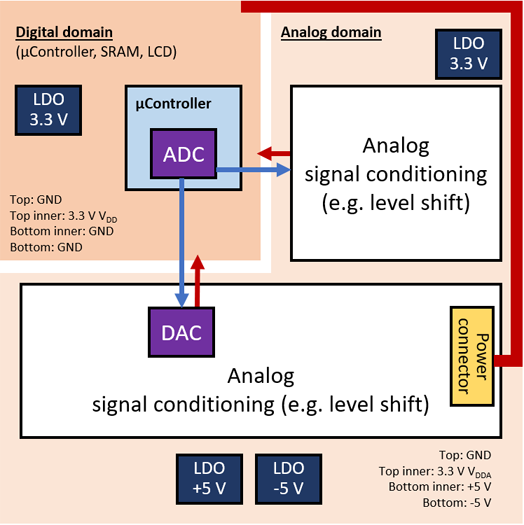So to aid the return current from the digital domain around the analog domain, I can separate the domains again, add a wide ground trace as shown in the third picture and include some thin ground return wires for my ADC and DAC interconnects.
No, you should use an unbroken ground plane.
I presume your micro is sending some fast digital signals like I2S to your DAC chip. These have corresponding return currents. If they are routed over a split in the ground plane, return current will take the long way around, resulting in a lot more noise.
I've had success with a simple solution: make the current draw of the noisy chip constant. This way, power supply and ground return currents between your micro and the power connector will be mostly DC, which should be harmless.
The ideal way is to use a shunt regulator fed from a current source. However, this has the substantial drawback of consuming a lot more power than necessary.
You can also cheat, by building a current divider, like so:

HF supply current for your micro will loop through local decoupling caps. Lower frequencies come from the LDO, which pulls that current from its input. I just used LM317 symbol for illustration.
The idea is to put a current divider at the input of the LDO with a pretty high resistor value and a large cap. You can also add ferrite beads to stop any HF noise from the micro leaking into your supply. When doing so, LDO input current will come from the lowest impedance source, which above 100Hz will be the capacitor. And the interesting thing is that your micro's ground currents will also return to the cap, not all the way to the power connector. So if you put the cap and the LDO somewhere in the upper left corner of your board, you can control the path your ground currents will take, and keep them away from the analog ground plane. You can even get fancy and use a second order RCRC filter, for example. Resistor value should be high, as you want voltage on the cap to ripple according to varying current drawn by the micro, so the current comes from the cap and not the power supply. If you want to be fancy, you could even replace it with a gyrator, to emulate a big inductor, but honestly a resistor is fine. This method works very well, but it needs a large cap, preferably with a low ESR. You've got low voltages though, so that won't be expensive.
If you want to minimize ground plane pollution, you also have to place your caps the opposite of the usual way. It tends to be "intuitive" to put the cap on the power pin because "duh it's a power decoupling cap". But if you put the GND pin of the cap next to the GND pin of the load instead, current will go through a shorter path in your ground plane. The ideal is of course when the chip has a nice pinout with GND and VCC next to each other so you can squeeze in the cap right there. But for the large pre-LDO cap, think about putting its GND pin next to the micro's ground pins. Doesn't matter if the power route to the LDO is 1cm longer. Basically something like that:

In addition, this large cap keeps the micro's pulsed currents not just out of your ground, but also out of the power supply, so it stays clean, and your opamps will be happy.
Note the ADC performance isn't stellar:

I'm not sure about the jitter performance of the micro's timer either.
The layer stackup is also weird, if you're using 4 layer.
If you have components on top, then you can't have a ground plane on top, because it won't be a ground plane, it'll be full of holes and cuts. If you want the return currents from your I2S and other digital signals to travel in the ground plane in a civilized way right under the trace, then you must put an unbroken GND plane on layer2, which on 4 layer is right below toplayer and very close. Then you get good coupling between toplayer and layer1, which means low noise and low emissions.
Then you no longer have a 3V3 plane but that's not a problem, your DAC chips don't have that many power pins, so you can just route power locally. Decoupling caps are more effective when inductance to ground is lower, which you will get if ground is only 0.2mm below on layer2. And since your DACs will draw pulsed HF currents, a ferrite bead on DVCC also helps keeping the main power supply clean. Ferrite beads and caps also make current dividers, which keep HF ground currents local, so you can split your board into little isolated islands which don't pollute each other. Make sure the beads don't ring with the caps.
Or you can put a power island on layer3 or layer4, if you don't need -5V there.
Also if you run opamps on +/-5V, and that comes from a SMPS, remember opamps' PSRR sucks at high frequency, so a simple filter with a ferrite bead helps a lot. For the same reason it would be a bad idea to use an isolated switching DC-DC, or any kind of DC-DC in the vicinity, without extra care about filtering, because these make a lot of noise that is correlated with current, and that is correlated with signal, so you get signal dependent noise.
On the matter of opamps, if you use them in inverting mode, you can add a bunch of resistors and turn that into a substractor, which means a differential input. So it can sense ground at the source of the signal, not necessarily at the spot in the ground plane where the feedback resistor happens to be, and that has much better rejection. Basically, read this.






